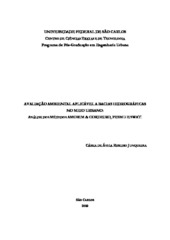Avaliação ambiental aplicável a bacias hidrográficas no meio urbano : análise dos métodos Amorim & Cordeiro, Pesmu e Swat
Abstract
The purpose of this research is to identify, systematize and evaluate three (3)
methodologies applied to hydrographic basins and developed for the planning and
management of the urban environment related to environmental concerns. The analyzed
methods are some of the ones developed at the Federal University in Sao Carlos itself, such
as PESMU and AMORIM & CORDEIRO, and a mathematical modeling with SWAT that
interfaces with the ARCVIEW software. The research methodology was developed from
the differences e similarities as for the used methods that were transformed in analysis
criteria. These criteria were selected prioritizing the focus on the conditions that the
evaluation method should offer to give support to the manager. For that reason, some
characteristics, such as reliability, scientific validity, the standardization and accessibility of
data were analyzed, so that, even when applied in different places, with distinct
characteristics, there could be a comparison between answers in the different cases. The
indicators of the methods were also analyzed to ascertain the range potential of the themes,
their interpretability and representativeness. Other factors are also extremely important for
managers, like application easiness and the type of cost involved in the analysis. The
discussion about the results was carried out based on a critical text listing positive and
negative aspects of the evaluated methods, besides a proposition of maintenance,
elimination or alteration of the analyzed items, as well as of a systematization of the
principal characteristics of each method. Before the performed analysis, the conclusion is
that there is not a method that is the best one, but the most appropriate for each particular
situation. While the AMORIM & CORDEIRO and PESMU methods have a more global
focus for the diagnosis, the SWAT method analyzes the basin physical characteristics more
deeply and becomes flexible in the interface with SIG. The three methods are
complementary when it comes to that complex environment that is a hydrographic basin,
since it contains interrelated physical, biological and social-economic information. The
more complex the analysis, the greater the efficacy, but it also increases the cost and the
response time, so all the characteristics should always be thought and pondered before the
choice of the method or methods to be applied on a specific place. Besides, the existing
input data should be checked so that the analyses do not become erroneous or subjective.
